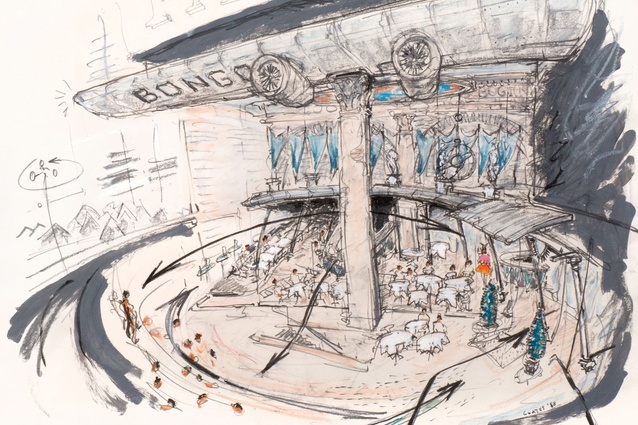Submitted by WA Contents
The changing landscape of architecture book publishing
United Kingdom Architecture News - May 26, 2014 - 14:44 3254 views

Nigel Coates, sketch for Caffè Bongo in Tokyo (1986) – a period of frenzied public interest in the glamour of architecture. Image: courtesy of Nigel Coates Studio
Is the architectural monograph losing its relevance, or can it still engender critical debate? Leon van Schaik considers what the recent flurry of publications about Australian firms contributes to contemporary practice.
Decades have passed since architectural monographs were hot property. In Tokyo in the late 1980s, you could stand in bookshops and watch piles of books a metre high disappear in a flurry of hands as staff replenished the piles from loaded trolleys. Such frenzied buying is not often seen by Australians, other than on Christmas Eve at South Melbourne Market, when staff shovelling prawns out of lorries fail to keep pace with the demand inside. Nowadays, publishers – with very rare exceptions – produce monographs at the expense of the architects that they feature, even if this embarrassing fact is masked in various kinds of contra dealings. In the 1980s, the demand was fuelled by a public newly fascinated by the glamour of architecture – a period when Nigel Coates could buy up loads of junk on the Portobello Road in London, ship it to Tokyo and create dream worlds such as Caffè Bongo (1986) or The Wall (1990) for a delirious public.
A few economic downturns later, and only El Croquis and possibly GGili (2G) produce quasi-monographs that are editorially driven, staking a claim for a particular architectural vision. Monographs today are often advertising, passed freely to existing and potential clients, and only rarely are they acts of reflection, stepping stones to a new surge of creative practice or capstones seeking to define the contribution of a long period of practice. In the former group, one hopes for a full record with plans, elevations, sections and clear descriptions of context, and a few sympathetic essays by friends. You hope to avoid the over-generous scholar who compares your work glowingly to the Renaissance master that he studies – cringingly embarrassing, that! – yet it has happened. All too often in this cluster, however, all that you get are carefully composed photographs that remove all possible contamination by people or places. A tabula rasa purity that shows up just how vacuous the whole endeavour has been....Continue Reading
> via ArchitectureAU
